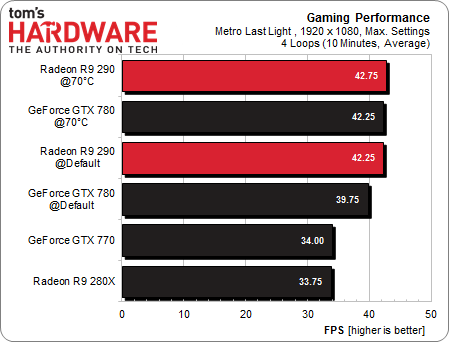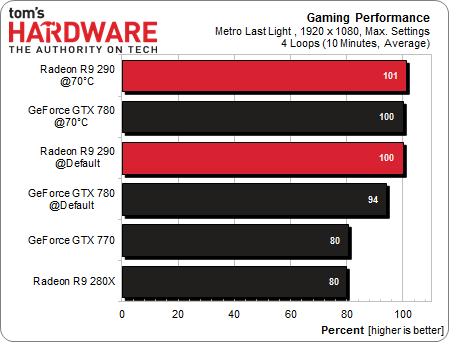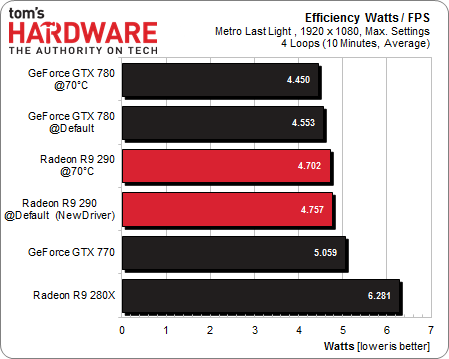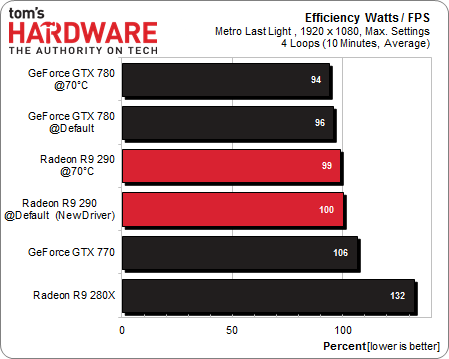AMD Radeon R9 290 Review: Fast And $400, But Is It Consistent?
We have all the makings of a dramatic launch: new high-end hardware, a last-minute delay for more performance, a crazy twist based on retail hardware, and our own home-baked solution to AMD's noise problem. Does Radeon R9 290 impress us or fall short?
Detailed Gaming Efficiency Results
Thanks to your requests in our feedback section, we’re including the benchmark performance results in our efficiency calculations. Specifically, we’re using the benchmarks recorded during our power consumption measurements. This is especially interesting due to the fact that Metro: Last Light isn't a Gaming Evolved title, so nobody can accuse it of favoring AMD.
We're testing at 1920x1080, given that resolution's popularity. The two faster and two slower graphics cards end up with fairly similar performance, which dispels any lingering doubt about this being an apples-to-oranges comparison. The graphs show the results for the Radeon R9 290 with its new driver and higher fan speed, since displaying three different results would have been confusing.
Gaming Loop Performance
Let’s first take a look at the plain frames per second and the frames per second percentages. This provides a nice overview.
With the new drivers that are supposed to keep the boisterous radial fan under control, AMD's Radeon R9 290 only gives up about one percent of its performance compared to eight percent with the old drivers. The performance difference is six percent for the Nvidia GeForce GTX 780. This doesn’t really make either of the two reference graphics cards look great. One gives up some of its performance, and the other one gets loud.
Efficiency
This is where power consumption enters the scene. We’re now judging the graphics cards based on how much power they need to achieve each of their frame rates. The GeForce GTX 780 does benefit from its better cooling, and manages to stay in the same place that we’ve become accustomed to. Then again, through some smart maneuvering, AMD manages to push its card to, or at least close to, the same level as Nvidia’s offering.
The Radeon R9 290 is only three to four percent less efficient than Nvidia's GeForce GTX 780. This is a pretty massive improvement over the 26 percent separating the AMD Radeon R9 280X and GeForce GTX 770. The fact that Nvidia's GeForce GTX 780 has already been the happy recipient of several optimized drivers, whereas the Radeon R9 290 is only supported by a beta driver should provide some food for thought, too. The gap between the two graphics cards could shrink, or even disappear altogether, at some point in the future.
Get Tom's Hardware's best news and in-depth reviews, straight to your inbox.
Current page: Detailed Gaming Efficiency Results
Prev Page Gaming Power Consumption Details Next Page Power Consumption Overview-
slomo4sho This is a win at $400! Good job AMD!Reply
http://techreport.com/review/25602/amd-radeon-r9-290-graphics-card-reviewed/9
11865199 said:However, the two retail Radeon R9 290X boards in our lab are both slower than the 290 tested today. They average lower clock rates over time, pushing frame rates down. Clearly there’s something wrong when the derivative card straight from AMD ends up on top of the just-purchased flagships. So who’s to say that retail 290s won’t follow suit, and when we start buying those cards, they prove to underperform GeForce GTX 780? We can only speculate at this point, though anecdotal evidence gleaned from our experience with R9 290X is suggestive.
Chris, these results differ drastically from real world results from 290X owners at OCN... I understand that your observations are anecdotal and based on a very small sample size but do you mind looking into this matter further because putting such a statement in bold in the conclusion even though it contradicts real world experiences of owners just provides a false assumption to the uninformed reader...
The above claim has already escalated further than it should... A Swiss site actually has already rebutted by testing their own press sample with a retail model and concluded the following:
With the results in hand, the picture is clear. The performance is basically identical between the press copy and graphics card from the shelf, at least in Uber mode. Any single frame per second is different, which is what may be considered normal as bonds or uncertainty in the measurements.
In the quiet mode, where the dynamic frequencies to work overtime, the situation becomes slightly turbid. A minor performance difference can be seen in some titles, and even if it is not about considerable variations, the trend is clear. In the end, it does an average variance tion of only a few percent, ie no extreme levels. The reason may include slightly less contact with the cooler, or simply easy changing ambient temperature. -
Heironious This is weird, something must be wrong with your system. I have an i5-2500, GTX 780, 16 GB G Skill 1333, 500 GB samsung SSD, Windows 8.1 64 bit, and on Ultra with 4x MSAA I get 80 - 100 FPS....Reply -
Heironious Multiplayer would add more stress to the CPUs / GPU's. Like I said, something is wrong with their machine. I would prob get higher on single player. Im going to check and find out.Reply -
slomo4sho Reply11865222 said:According to Tom's Benchmarks Nvidia's price drop just became meaningless
Now to wait for the non-reference cards at the end of the month! -
jimmysmitty I agree that the stock cooling is pretty bad but in honesty, no matter how nice they make it after market is always better. The Titan may not have had after market but if it did it would have cooled better.Reply
It looks like a good card for the price as it even keeps up with the $100 more GTX780. This is good as NVidia may drop prices even more which means we could also see a price drop on the 290X and I wouldn't mind a new 290X Toxic for sub $500. -
guvnaguy In terms of potential performance it seems like a great card, but you get what you pay for with regards to chip quality and cooling.Reply
Best to wait a month or two before buying to see how this all goes down




